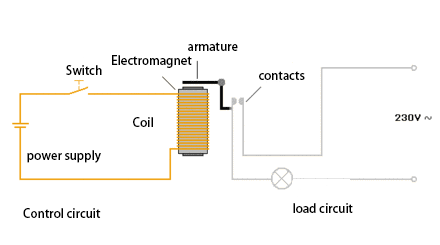A relay is an electronic device that enhances the electrical energy storage capacity of a circuit by storing and releasing energy, allowing the circuit to remain stable during power outages or voltage fluctuations. The application range of relays is very wide, including but not limited to UPS, solar energy systems, electric vehicles, medical equipment and communication systems and other fields. This article will introduce the principle, types, advantages and disadvantages and applications of relays in detail.
Ⅰ. The principle of the relay
The principle of the relay can be simply summarized as the process of "energy storage-energy release". When the circuit is operating normally, the relay stores energy through internal batteries or supercapacitors and other devices. Once the voltage fluctuates or the power is cut off in the circuit, the relay will automatically release the stored energy to maintain the normal operation of the circuit. The energy storage and energy release process of the relay is realized through the internal control circuit and switch circuit.

Ⅱ.Types of relays
1. Electromagnetic relay
The electromagnetic relay is one of the most common types of relays. It controls the switch of the relay through the action of an electromagnet, and has the advantages of sensitive action and quick response. Electromagnetic relays can be classified according to parameters such as control voltage and contact current carrying capacity, and are often used in power systems, automatic control systems, communication systems and other fields.

2. Capacitive relay
The working principle of the capacitive relay is to use the charge and discharge of the capacitor to control the switch state. It has the advantages of fast action speed, low noise and long life. It is widely used in high-speed transmission systems, precision measuring instruments, high-frequency circuits and other occasions.
3. Photoelectric relay
The photoelectric relay realizes the switch control through the detection of the photoelectric sensor and the feedback of the control circuit, and has the advantages of high reliability and strong anti-interference ability. Photoelectric relays are often used in industrial automation, photoelectric control systems, electronic circuits and other fields.
4. Magnetic relay
The magnetic relay is a kind of relay that uses the attraction of the magnetic field to control the switch state. It has the characteristics of simple structure, long life and good stability. Magnetic relays are widely used in magnetic sensors, magnetic read-write heads, automatic control systems and other fields.
5. Pneumatic relay
The pneumatic relay is a relay that uses the action of pneumatic components to control the switch state. It has the advantages of fast action speed, high precision, and strong anti-interference. Pneumatic relays are often used in pneumatic control systems, hydraulic control systems and other fields.
Ⅲ.Advantages, disadvantages and applications of relays
1. Advantages of relays:
Extend the power supply before and after the power outage of the circuit, avoiding the inconvenience and loss caused by power interruption;
Reduce circuit overload and protect electrical equipment from overcurrent or overvoltage damage;
Stable power supply and maintain the stable working condition of electrical equipment;
Save power and avoid the situation where electrical equipment consumes a lot of power when restarting after a power outage.
2. Disadvantages of relays:
The cost of the battery pack is relatively high and requires a certain amount of investment;
Some relays may generate electromagnetic interference or noise, which may affect other electrical equipment;
Some relays may bring certain fluctuations to the circuit and affect the stability of electrical equipment.
3. Application of relays:
Power protection in industrial automation control systems;
Electricity control and conversion in solar cells and wind generators;
Endurance of power supplies such as electric vehicles and drones;
Fields requiring stable power supply, such as medical equipment and security equipment.
Ⅳ.Summary
As a common electrical component, the relay has a wide range of application scenarios. Different types of relays have their own advantages and disadvantages and are used in different fields. The development process of relays has gone through the transformation from mechanical to electronic. Modern relay technology is becoming more and more advanced, and its performance is constantly improving, making it play an increasingly important role in modern automation control systems. In the future, with the continuous advancement of science and technology and the increasing demand for electrical components, the technology of relays will be further developed and applied.
Related Articles

We are a professional distributor of electronic components, providing a wide range of electronic products, saving you a lot of time, effort and cost through our meticulous order preparation and fast delivery service.
Share this post


